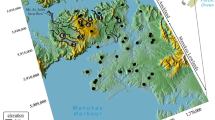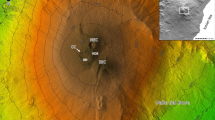Abstract
Simulating lava flows on a gentle slope is complex since they can propagate in a wide range of directions. It is an even greater challenge to define lava flow trajectories when an eruption lasts over several years and flows cool down, changing the surrounding topography. In this study, we test Q-LavHA, an open source plug-in that simulates lava flow inundation calculating its probability, and using Paricutin’s eruption (1943–1952) in central Mexico as a case study. We have appropriately calibrated the Q-LavHA plug-in for the Paricutin case study, which provides insights on how to better model lava flows in gentle terrain. From this work, we observe that each phase is characterized by a unique set of parameters requiring a careful calibration and that low-relief topographies require special consideration. Our findings could be useful for real-time hazard evaluation in future volcanic scenarios in the Michoacán–Guanajuato volcanic field and elsewhere, where new monogenetic eruptions similar to Paricutin can be expected.





Similar content being viewed by others
Code availability
Not applicable.
References
Bartolini S (2014) Volcanic hazard assessment in monogenetic volcanic fields. PhD dissertation. University of Barcelona
Bartolini S, Geyer A, Martí J, Pedrazzi D, Aguirre-Díaz G (2014) Volcanic hazard on Deception Island (South Shetland Islands). J Volcanol Geotherm Res. https://doi.org/10.1016/j.jvolgeores.2014.08.009
Bertin D, Lindsay JM, Becerril L, Cronin SJ, Bertin LJ (2019) MatHaz: a Matlab code to assist with probabilistic spatio-temporal volcanic hazard assessment in distributed volcanic fields. J Appl Volcanol 8(1):4
Becerril L, Martí J, Bartolini S, Geyer A (2017) Assessing qualitative long-term volcanic hazards at Lanzarote Island (Canary Islands). Nat Hazards Earth Syst Sci 2017(17):1145–57
Bertino E, Damiani ML, Groppelli G, Norini G, Aldighieri B, Borgonovo S, Comoglio F, Pasquaré G (2006) Modelling lava flow to assess hazard on Mount Etna (Italy). From geological data to a preliminary hazard Map. International Congress on Environmental Modelling and Software, p 345
Booth B (1979) Assessing volcanic risk. J Geol Soc London 136:331–340
Bullard FM (1947) Studies on Paricutin volcano. Geol Soc Am Bull 58:433–449
Cappello A, Bilotta G, Neri M, Negro CD (2013) Probabilistic modeling of future volcanic eruptions at Mount Etna. J Geophys Res Solid Earth 118(5):1925–1935
Chevrel MO, Siebe C, Guilbaud M-N, Salinas S (2016) The AD 1250 El Metate shield volcano (Michoacán): Mexico’s most voluminous Holocene eruption and its significance for archeology and hazards. The Holocene 26(3):471–488
Cordonnier B, Lev E, Garel F (2016) Benchmarking lava-flow models. Geol Soc London Spec Publ 426:425–445. https://doi.org/10.1144/SP426.7
Connor CB (1987) Structure of the Michoacán–Guanajuato volcanic field. Mexico J Volcanol Geotherm Res 33(1–3):191–200
Connor LJ, Connor CB, Meliksetian K, Savov I (2012) Probabilistic approach to modeling lava flow inundation: a lava flow hazard assessment for a nuclear facility in Armenia. J Appl Volcanol 1:1–19. https://doi.org/10.1186/2191-5040-1-3
Connor CB, Connor LJ, Germa A, Richardson JA, Bebbington M, Gallant E, Saballos JA (2019) How to use kernel density estimation as a diagnostic and forecasting tool for distributed volcanic vents. Stat Volcanol 4(3):1–25
Crisci GM, Avolio MV, Behncke B, D’Ambrosio D, Di Gregorio S, Lupiano V, Neri M, Rongo R, Spataro W (2010) Predicting the impact of lava flows at Mount Etna. Italy J Geophys Res 115:B04203. https://doi.org/10.1029/2009JB006431
Damiani ML, Groppelli G, Norini G, Bertino E, Gigliuto A, Nucita A (2006) A lava flow simulation model for the development of volcanic hazard maps for Mount Etna (Italy). Comput Geosci 32(4):512–526
de’ Michieli Vitturi M, Tarquini S (2018) MrLavaLoba: a new probabilistic model for the simulation of lava flows as a settling process. J Volcanol Geotherm Res 349:323–334
Del Negro C, Cappello A, Neri M, Bilotta G, Hérault A, Ganci G (2013) Lava flow hazards at Mount Etna: constraints imposed by eruptive history and numerical simulations. Sci Rep 3 (1)
Dietterich HR, Lev E, Chen J, Richardson JA, Cashman KV (2017) Benchmarking computational fluid dynamics models of lava flow simulation for hazard assessment, forecasting, and risk management. J Appl Volcanol 6(1):9
Felpeto A, Martí J, Ortiz R (2007) Automatic GIS-based system for volcanic hazard assessment. J Volcanol Geotherm Res 166:106–116
Foshag WF, González-Reyna J (1956) Birth and development of Parícutin volcano, Mexico. US Geol Surv Bull 965D:355–485
Fries C (1953) Volumes and weights of pyroclastic material, lava and water erupted by Parícutin volcano, Michoacán. Mexico Trans Am Geophys Union 34(4):603–616
Gardine M, West ME, Cox T (2011) Dike emplacement near Parícutin volcano, Mexico in 2006. Bull Volcanol 3:123–132
Granados HD, Jenkins S (2015) Extreme volcanic risks 1: Mexico City. Volcanic hazards, risks and disasters. Elsevier, Amsterdam, pp 315–354
Guilbaud MN, Siebe C, Layer P, Salinas S, Castro-Govea R, Garduno-Monroy VH, Le Corvec N (2011) Geology, geochronology, and tectonic setting of the Jorullo Volcano region, Michoacan, Mexico. J Volcanol Geotherm Res 201:97–112
Guilbaud M-N, Siebe C, Layer P, Salinas S (2012) Reconstruction of the volcanic history of the Tacámbaro-Puruarán area (Michoacán, México) reveals high frequency of Holocene monogenetic eruptions. Bull Volcanol 74(5):1187–1211
Harris AJL, Rowland SK (2001) FLOWGO: a kinematic thermo-rheological model for lava flowing in a channel. Bull Volcanol 63:20–44. https://doi.org/10.1007/s004450000120
Hasenaka T (1994) Size, distribution, and magma output rate for shield volcanoes of the Michoacán–Guanajuato volcanic field, Central Mexico. J Volcanol Geotherm Res 63:13–31
Hasenaka T, Carmichael ISE (1985) The cinder cones of Michoacán–Guanajuato, Central Mexico: their age, volume and distribution, and magma discharge rate. J Volcanol Geotherm Res 25:105–124
Inbar M, Lugo Hubp J, Villers Ruiz L (1994) The geomorphological evolution of the Paricutin cone and lava flows, Mexico, 1943–1990. Geomorphol 9:57–76
Kereszturi G, Németh K (2012) Monogenetic basaltic volcanoes: genetic classification, growth, geomorphology and degradation. Updates in volcanology-new advances in understanding volcanic systems. IntechOpen, Hamilton
Krauskopf K, Williams H (1946) The activity of Parícutin during its third year. Trans Am Geophys Union 27:406–410
Kshirsagar P, Siebe C, Guilbaud M-N, Salinas S, Layer PW (2015) Late Pleistocene Alberca de Guadalupe maar volcano (Zacapu basin, Michoacán): stratigraphy, tectonic setting, and paleohydrogeological environment. J Volcanol Geoth Res 304:214–236
Larrea P, Salinas S, Widom E, Siebe C, Abbitt RJF (2017) Compositional and volumetric development of a monogenetic lava flow field: the historical case of Paricutin (Michoacán, Mexico). J Volcanol Geotherm Res 348:36–48
Larrea P, Widom E, Siebe C, Salinas S, Kuentz D (2019a) A re-interpretation of the petrogenesis of Paricutin volcano: Distinguishing crustal contamination from mantle heterogeneity. Chem Geol 504:66–82
Larrea P, Siebe C, Juárez-Arriaga E, Salinas S, Ibarra H, Böhnel H (2019b) The~ AD 500–700 (Late Classic) El Astillero and El Pedregal volcanoes (Michoacán, Mexico): a new monogenetic cluster in the making? Bull of Volcanol 81(10):59
Larrea P, Albert H, Ubide T, Costa F, Colás V, Widom E, Siebe C (2021) From explosive vent opening to effusive outpouring: mineral constraints on magma dynamics and timescales at Paricutin monogenetic volcano. J Petrol. https://doi.org/10.1093/petrology/egaa112
Loughlin SC, Sparks RSJ, Sparks S, Brown SK, Jenkins SF, Vye-Brown C (eds) (2015) Global volcanic hazards and risk. Cambridge University Press, Cambridge
Luhr JF, Simkin T (1993) Parícutin. The Volcano born in a Mexican cornfield. Geoscience Press, Phoenix
Mahgoub AN, Böhnel H, Siebe C, Salinas S, Guilbaud M-N (2017) Paleomagnetically inferred ages of a cluster of Holocene monogenetic eruptions in the Tacámbaro-Puruarán area (Michoacán, México): implications for volcanic hazards. J Volcanol Geoth Res 347:360–370
Mahgoub AN, Reyes-Guzmán N, Böhnel H, Siebe C, Pereira G, Dorison A (2018) Paleomagnetic constraints on the ages of the Holocene Malpaís de Zacapu lava flow eruptions, Michoacán (Mexico): implications for archeology and volcanic hazards. Holocene 28(2):229–245
Martí J (2017) Assessing volcanic hazard: a review. Oxford Handbooks. https://doi.org/10.1093/oxfordhb/9780190699420.013.32
McBirney AR, Taylor HP, Armstrong RL (1987) Paricutin re-examined: a classic example of crustal assimilation in calc-alkaline magma. Contrib Mineral Petrol 95:4–20
Mossoux S, Saey M, Bartolini S, Poppe S, Canters F, Kervyn M (2016) Q-LAVHA: A flexible GIS plugin to simulate lava flows. Comput Geosci 97:98–109
Nolan ML, Gutiérrez C (1979) Impact of Parícutin on five communities. In: Activity Volcanic, Ecology Human (eds) Sheets and Grayson. Academic Press, New York, pp 293–338
Ordoñez E (1943) The new volcano of Paricutin. University of Texas, Institute of Latin American Studies, Texas, pp 62–78
Pizón JI, Núñez-Cornú FJ, Rowe CA (2017) Magma intrusion near Volcan Tancitaro: evidence from seismic analysis. Phys Earth Planet Inter 262:66–79
Reyes-Guzmán N, Siebe C, Chevrel MO, Guilbaud MN, Salinas S, Layer P (2018) Geology and radiometric dating of Quaternary monogenetic volcanism in the western Zacapu lacustrine basin (Michoacán, México): implications for archaeology and future hazard evaluations. Bull Volcanol 80:18
Rymer H (2015) Part VII volcanic hazards. In: Sigurdsson H (ed) The encyclopedia of volcanoes, 2nd edn. Elsevier, Amsterdam, pp 895–896
Segerstrom K (1950) Erosion studies at Parícutin, State of Michoacán, Mexico. U.S. Geol Surv Bull 965A:1–164
Siebe C, Macias JL (2006) Volcanic hazards in the Mexico City metropolitan area from eruptions at Popocatepetl, Nevado de Toluca, and Jocotitlan stratovolcanoes and monogenetic scoria cones in the Sierra Chichinautzin volcanic field. In: Siebe C, Macias JL, Aguirre-Diaz GJ (eds) Neogene-quarternary continental margin volcanism: a perspective from México, vol 402. Geological Society of America, Boulder, pp 253–329
SSN (2020) Servicio Sismológico Nacional, Instituto de Geofísica, Universidad Nacional Autónoma de México, México. http://www.ssn.unam.mx
Tarquini S, Vitturi MDM, Jensen E, Pedersen G, Barsotti S, Coppola D, Pfeffer MA (2019) Modeling lava flow propagation over a flat landscape by using MrLavaLoba: the case of the 2014–2015 eruption at Holuhraun. Iceland Annals of Geophysics 62(2):228
Trask P (1945) The Mexican volcano Paricutin. Science 95:501–505
Valentine GA, Connor CB (2015) Basaltic volcanic fields. In: Sigurdsson H, Houghton BF, McNutt SR, Rymer H, Stix J (eds) Encyclopedia of Volcanoes, 2nd edn. Academic Press, London, pp 423–439
Walker GPL (2000) Basaltic volcanoes and volcanic systems. In: Sigurdsson H, Houghton BF, McNutt SR, Rymer H, Stix J (eds) Encyclopedia of volcanoes. Academic Press, San Diego, pp 283–290
Wilcox RE (1954) Petrology of Parícutin Volcano, Mexico. U.S. Geol Surv Bull 965C:281–353
Yokoyama I, De la Cruz-Reyna S (1990) Precursory earthquakes of the 1943 eruption of Paricutin volcano, Michoacan. Mexico J Volcanol Geotherm Res 44(3–4):265–281
Acknowledgements
We would like to stress our gratitude to Elisabeth A. Gallant and Simone Tarquini for their painstaking and constructive review that undoubtedly has strongly improved our manuscript. We also thank Editor James Goff for his guidance and editorial handling.
Funding
This research was supported by the Government of Spain through “Juan de la Cierva” postdoctoral fellowship awarded to L. Becerril; NSF EAR 1019798 (2014–2016) and a UNAM-DGAPA postdoctoral fellowship (2018–2019) granted to P. Larrea; National Science Foundation (NSF) EAR grant #1019798 awarded to E. Widom. Consejo Nacional de Ciencia y Tecnología (CONACyT-167231) and Dirección General de Asuntos del Personal Académico (UNAM-DGAPA-IN-104221) granted to C. Siebe; and VeTOOLS and EVE projects funded by the European Commission (EC ECHO SI2.695524 and 826292EC ECHO SI2.695524) granted to J. Martí.
Author information
Authors and Affiliations
Contributions
L.B. and P.L. conceived and developed the original idea and took the lead in writing the manuscript, designed the figures, tables, and supplementary material. L.B. performed the numerical simulations with the input of P.L., S.M, D.F, and S.S. The reconstructed paleotopography and DEMs were fully created by S.S. All authors provided critical feedback and helped shape the research and approved the final manuscript.
Corresponding author
Ethics declarations
Conflict of interest
The authors declare that they have no conflict of interest.
Additional information
Publisher's Note
Springer Nature remains neutral with regard to jurisdictional claims in published maps and institutional affiliations.
Supplementary Information
Below is the link to the electronic supplementary material.
Rights and permissions
About this article
Cite this article
Becerril, L., Larrea, P., Salinas, S. et al. The historical case of Paricutin volcano (Michoacán, México): challenges of simulating lava flows on a gentle slope during a long-lasting eruption. Nat Hazards 107, 809–829 (2021). https://doi.org/10.1007/s11069-021-04607-x
Received:
Accepted:
Published:
Issue Date:
DOI: https://doi.org/10.1007/s11069-021-04607-x




